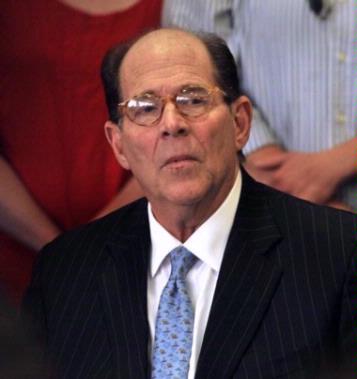Dobelle Doubles Down on Suit vs. WSU
By Stephanie Kraft
Evan Dobelle, who left Westfield State University under a cloud because of extravagant spending, has added a new complaint to his suit against the school (“Dobelle Sues. Should Anyone Be Surprised?”, November 7, 2013). His latest claim is that in a secret telephone conversation in October, Massachusetts Higher Education Commissioner Richard Freeland ordered John F. Flynn III, chairman of WSU’s board of trustees, not to allow Dobelle to resign in the wake of accusations of excessive spending, but to fire him. The trustees’ solution was to place Dobelle on paid leave; he resigned a few weeks later.
Freeland had frozen $2 million in state funding for WSU while the trustees investigated the spending, but authorized the release of $200,000 after the suspension. Dobelle’s lawyer has represented Freeland’s action as evidence that Freeland was coercing the school into terminating Dobelle.
The lawyer, Ross H. Garber of Hartford, who specializes in serving clients being investigated by Congress or state legislatures, declined to answer a query from the Daily Hampshire Gazette about what evidence he had that the phone conversation took place. The Advocate was unable to reach Garber, but spoke to Flynn, who is an administrator with the state police, at his office. Asked if the conversation referenced in the filing occurred, Flynn said, “That’s a matter of litigation. I’m not interested in commenting on anything to do with the litigation at this point.”
The issues surrounding Dobelle’s spending and departure could be expensive for WSU. The university is obliged to cover legal expenses incurred by its president in the course of his work and may have to pay $900,000 in legal bills Dobelle ran up before he was put on leave. WSU also owes about $500,000 to the law firm it hired when the state began its own investigation of Dobelle’s expenditures.•
Recession Claims Gus and Paul’s
Gus and Paul’s Deli, long a landmark in Springfield, closed on New Year’s Eve and will not re-open until Valentine’s Day, if at all. Long a favorite with voters in the Advocate’s Best of the Valley readers’ poll, Gus and Paul’s offered everything from kosher hot dogs to cannoli; its menu was a mirror of the tastes of Springfield residents. Soups, salads, baked goods and desserts were all made with natural ingredients and no preservatives.
In G and P’s glory days, Reubens were a dollar off on Tuesdays; on Fridays you could buy six house-made boiled bagels and get three free; and kids under eight got a free cupcake on Saturdays. But in spite of the deli’s longtime popularity, in February, 2013 the state Department of Revenue nearly closed it for nonpayment of $57,639.47 in back taxes.
The 55-year-old business has fallen victim to a sagging economy that caused its catering sales to commercial customers to drop off. And it’s not just independent bookstores and hardware shops that lose business to the chains: Gus and Paul’s trade was undercut by big-box stores that sold bakery goods at lower prices than those charged for the house-made items at the deli.• —SK
There Is (Earning) Power in the Union—Especially for Women
By Maureen Turner
Women who belong to labor unions earn, on average, 12.9 percent more than women workers who don’t belong to unions, according to a new reportGus by the Center for Economic and Policy Research. That translates into an additional $2.50 an hour.
The study—which controlled for factors including age, race, industry, education and state of residence—also found that female union members are 36.8 percent more likely than those not affiliated with unions to have health insurance provided by their employers, and 53.4 percent more likely to have a retirement plan sponsored by their employers. And the benefits of union membership are greater for women with less education, the researchers found: “[F]or a woman worker with a high school degree, being in or represented by a union raises her likelihood of having health insurance or a retirement plan by more than earning a four-year college degree would.”
In 2012, women accounted for 45.9 percent of total union membership in the U.S. That figure, however, is on the rise; according to the report, by 2023, the majority of American union workers will be women. Still, union membership overall remains on a decline: in 1983, 18 percent of women and 27.7 percent of men belonged to unions; by 2012, those figures had dropped to 11.8 percent and 13.1 percent respectively.
“Considering the great boost to pay and benefits that unions bring, it’s important that anyone who cares about the wellbeing of women workers also care about unions,” Nicole Woo, a co-author of the study, said in announcing the findings.
The report is available at www.cepr.net.•



